Well, now, since it was so long ago and all this talk has me craving these little cakes (and because Mr. Shakespeare would have approved), I'm going to order some from Mr. Brown and try them again. The Original Cake Shop apparently ships them worldwide, as they have since the 18th century. Once again, I'll keep you posted! Meanwhile, here's another poetic morsel to tide you over: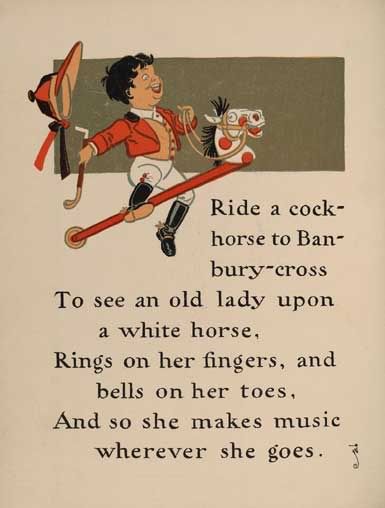
From Denslow's Mother Goose, 1902.
While reading up on Medieval/Elizabethan food for Shakespeare's birthday yesterday, some very fetching banbury cakes insisted that I pay attention to them.
Naturally, I was reminded of the English nursery rhyme, and the time Len and I traveled to Banbury for a taste of those famous cakes. Food, you see, is always the great motivator.
First, a little about the rhyme, which in the version I'm most familiar with, cites a "fine lady," rather than an old one. It's widely held that she's Queen Elizabeth I, who traveled to Banbury to visit a stone cross that had just been erected. The town is located at the top of a steep hill, so a large white stallion was often used to help carriages up.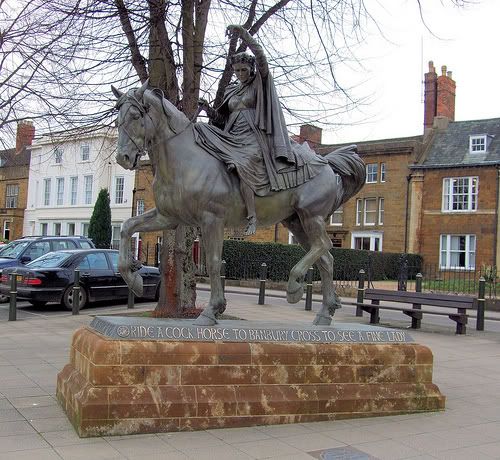
photo of "Fine Lady" by Jim Linwood.
Seems a wheel broke on the Queen's carriage, so she was obliged to mount the horse and ride to the cross. The town had decorated the horse with lovely ribbons and bells, and minstrels accompanied her ("she shall have music wherever she goes"). Unfortunately, the original Banbury Cross was destroyed by Puritans in 1602, but another replaced it in 1859: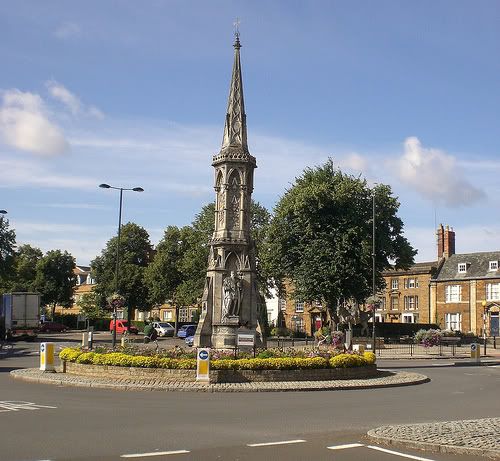
This was built to commemorate the marriage of Queen Victoria's eldest daughter to Prince Frederick of Prussia (photo by Running in Suffolk).
*rubs hands together and licks lips*
Now, for the cakes. They date back to the 13th century, when returning Crusaders brought back fruit and spices from the Near East. The Elizabethans were sugar crazy, and the Queen's legendary sweet tooth turned her set of chompers black. During Shakespeare's time, Banbury was widely known for its cheese and cakes. It is believed that poet and dramatist, Ben Jonson, attended the Banbury Fair (famous in England for centuries), and while there, visited the bakehouse, and chatted with the owner, Richard Busby. Not too long after, Jonson wrote his famous comedy, "Bartholomew Fair," where the cakes are mentioned by the character Quarlous:
I remember that, too, out of a scruple he took that, in spiced conscience, those cakes he made were served to bridals, may-poles, morrises and such profane feasts and meetings.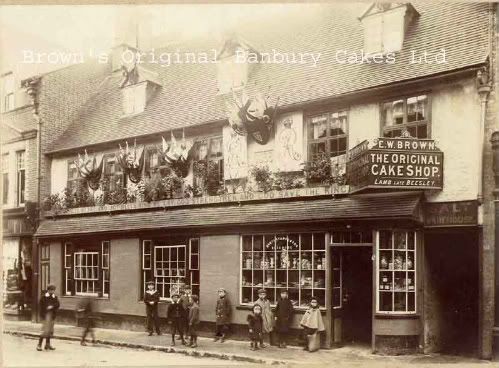
Original Cake Shop, 1902.
There is evidence of a pre-existing bakehouse dating back to the 13th century in the same location where the present day "Original Cake Shop," (circa 1550), now stands. Ownership changed hands through the years, but the family of E.W. Brown has been associated with the "Original Banbury Cake" since 1868. Apparently the cakes are still baked by hand, according to the family's secret, historic recipe, under the supervision of Philip Brown.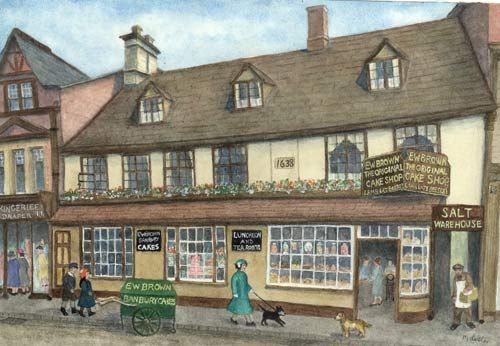
from "Memories of Banbury" by Marjory Lester.
Just what are these famous cakes like? They're puff pastry, usually oval shaped, filled with currants, other fruits, flavorings, spices, and sprinkled with cane sugar. I vaguely remember eating mine while standing on some sort of foot bridge. It was so long ago that I thought maybe I had imagined it. I asked Len the other night (he of the exacting memory) -- and sure enough, he remembers buying them warm from the bake shop and biting into the currant filling.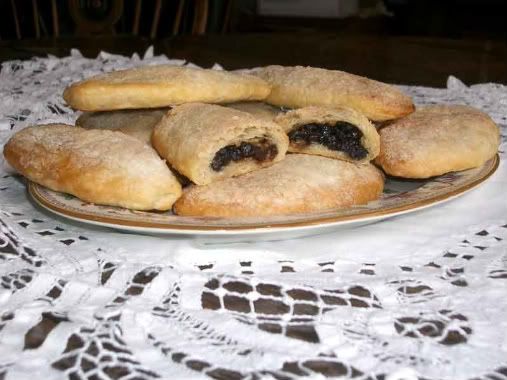
Brown's Original Banbury Cakes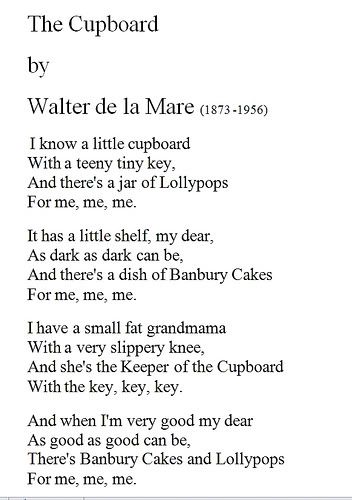
Lisa Chellman has trays of freshly baked poems in her cupboard today at Under the Covers. Stop in and sample as many as you like!
Several juicy morsels for the road:
Elizabethans considered sugar an aphrodisiac. A nobleman's meal always ended with a sweet course, called "The Banquet." It was designed to "moveth pleasure and lust of the body."
Sweets were often served on plates, called "roundels" or "banqueting dishes," which had an image or poem on them. Often these poems contained sexual innuendos and double entendres.
During Shakespeare's time, sonnets were all the rage. Poems were sometimes baked into walnut-sized pastries -- sort of like modern day fortune cookies.
*fans self*
Here's a recipe for banbury cakes (sshhh! don't tell Mr. Brown).
ONE MORE THING:
A very special Happy Birthday to Sara Lewis Holmes, Poetry Princess and novelist extraordinaire! As I said before, April is a good month for poetry -- Wordsworth, Shakespeare, Walter de la Mare, and Lee Bennett Hopkins were all born in April, along with three Poetry Princesses: Sara, Kelly Fineman and Liz Scanlon!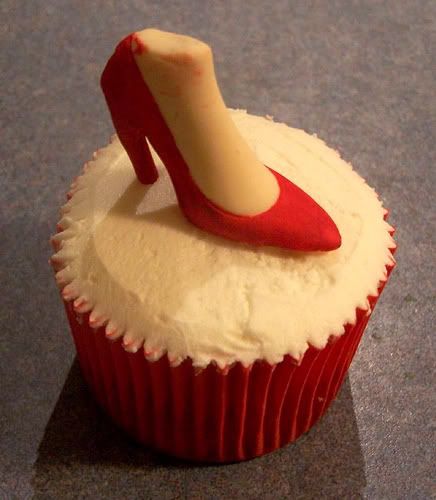
"A Shoe Sonnet for Sara" (cake of choice for runway writers).
photo by Sandra socake.
"Ride a cock horse to Banbury Cross,
To see what Tommy will buy.
A little white loaf and a little white cake,
And a tupenny apple pie."
new posts in all blogs
.jpg?picon=910) By: Jama Rattigan,
on 4/24/2009
By: Jama Rattigan,
on 4/24/2009
Blog: jama rattigan's alphabet soup (Login to Add to MyJacketFlap)
JacketFlap tags: banbury cakes, poetry friday, walter de la mare, poetry and cake month, Add a tag
Viewing: Blog Posts Tagged with: banbury cakes, Most Recent at Top [Help]
Results 1 - 1 of 1
Blog: jama rattigan's alphabet soup (Login to Add to MyJacketFlap)
JacketFlap tags: banbury cakes, poetry friday, walter de la mare, poetry and cake month, Add a tag


